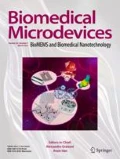Abstract
The poses of robotic endoscopic capsules are indispensable for further follow-up examinations, potential targeted drug delivery, and closed-loop controlling of active locomotion. A novel tracking method using the multiple magnetic excitations with frequency division has been investigated. The multiple excitation coils can simultaneously work at different frequency to improve real-time tracking. A novel model between the magnetic flux density and the capsule’s pose has been derived, which shows a nonlinear equation group with multiple local extremum. Then, a Back-Propagation (BP) neural network algorithm combined with the mother wavelet is investigated to solve the pose. To reduce the volume and power consumption, the wireless magnetic sensing module uses digital signal processing as the core framework, which is beneficial to be miniaturized to integrate with the capsule. The functional prototype of the tracking system has been developed, which consists of a wireless magnetic sensing module mounted in the capsule, a magnetic excitation module with frequency division, a wireless receiver and data interface, an excitation coil array and a platform for pose solving. The experimental results show that the mean errors are 0.0098 m in x-component, 0.0122 m in y-component, 0.0077 m in z-component, 0.187 rad in α-component and 0.161 rad in β-component, respectively. The real-time performance of the tracking system is improved.








Similar content being viewed by others
References
F. Bianchi, A. Masaracchia, E.S. Barjuei et al., Localization strategies for robotic endoscopic capsules: a review. Expert Rev. Med. Devices 16(21), 1–23 (2019)
R. Chandra, A.J. Johansson, M. Gustafsson et al., A Microwave Imaging-Based Technique to Localize an In-Body RF Source for Biomedical Applications. IEEE Trans Biomed Eng 62(5), 1231 (2015)
G. Ciuti, R. Caliò, D. Camboni et al., Frontiers of robotic endoscopic capsules: a review. J. Micro-Bio Robot. 11, 1–18 (2016)
G. Ciuti, A. Menciassi, P. Dario, Capsule endoscopy: from current achievements to open challenges. IEEE Rev. Biomed. Eng. 4, 59–72 (2011)
S.T. Goh, S.A.R. Zekavat, K. Pahlavan, DOA-Based Endoscopy Capsule Localization and Orientation Estimation via Unscented Kalman Filter. IEEE Sens. J. 14(11), 3819–3829 (2014)
M. Grzeskowiak, F.E. Hatmi, A. Diet et al., Coils for ingestible capsules: near-field magnetic induction link. CR. Phys. 16, 819–835 (2015)
X. Guo, Z. Lu, H. Cui et al., Modelling and solving the position tracking problem of remote-controlled gastrointestinal drug-delivery capsules. Biomed. Signal Process. Control 39(1), 213–218 (2018)
X. Guo, C. Song, R. Yan, Optimization of multilayer cylindrical coils in a wireless localization system to track a capsule-shaped micro-device. Measurement 46, 117–124 (2013)
M.C. Hoang, V.H. Le, J. Kim et al., Untethered Robotic Motion and Rotating Blade Mechanism for Actively Locomotive Biopsy Capsule Endoscope. IEEE Access. PP(99):1–12 (2019)
C. Hu, Y. Ren, X. You et al., Locating intra-body capsule object by three-magnet sensing system. IEEE Sensor. J. 16, 5167–5176 (2016)
G. Iddan, G. Meron, A. Glukhovsky, P. Swain, Wireless capsule endoscopy. Nature 405, 417–420 (2000)
S.S. Mapara, V.B. Patravale, Medical capsule robots: a renaissance for diagnostics, drug delivery and surgical treatment. J. Control. Release 261, 337–351 (2017)
H. Mateen, R. Basar, A.U. Ahmed et al., Localization of Wireless Capsule Endoscope: A Systematic Review. IEEE Sens. J. 17(5), 1197–1206 (2017)
A.R. Nafchi, S.T. Goh, S.A.R. Zekavat, Circular Arrays and Inertial Measurement Unit for DOA/TOA/TDOA-Based Endoscopy Capsule Localization: Performance and Complexity Investigation. IEEE Sens. J. 14(11), 3791–3799 (2014)
C. Natali, M. Beccani, P. Valdastri, Real-Time Pose Detection for Magnetic Medical Devices. IEEE Trans. Magn. 49(7), 3524–3527 (2013)
D. Son, S. Yim, M. Sitti, A 5-d localization method for a magnetically manipulated untethered robot using a 2-d array of hall-effect sensors. IEEE/ASME Trans. Mechatron. 21, 708–716 (2016)
A.Z. Taddese, P.R. Slawinski, M. Pirotta et al., Enhanced Real-Time Pose Estimation for Closed-Loop Robotic Manipulation of Magnetically Actuated Capsule Endoscopes[J]. The International Journal of Robotics Research 37(8), 890–911 (2018)
M. Turan, J. Shabbir, H. Araujo et al., A deep learning based fusion of RGB camera information and magnetic localization information for endoscopic capsule robots. Int. J. Intel. Robot. Appl. 4, 442–450 (2017)
I. Umay, B. Fidan, Adaptive wireless biomedical capsule tracking based on magnetic sensing. Int. J. Wirel. Inform. Netw. 6, 1–11 (2017a)
I. Umay, B. Fidan, Adaptive wireless biomedical capsule tracking based on magnetic sensing. Int. J. Wirel. Inform. Netw. 24, 189–199 (2017b)
I. Umay, B. Fidan, B. Barshan, Localization and tracking of implantable biomedical sensors. Sensor. 17, 583–602 (2017)
M. Xu, D. Kong, L. Ye, L. et al., A new localization system for tracking capsule endoscope robot based on digital 3-axis magnetic sensors array. In Proc. 2017 Chinese Intel. Syst. Conf. Mudanjiang, China. 14–15 October 487–494 (2017)
P. Zhang, J. Li, Y. Hao et al., The role of computed tomography data in the design of a robotic magnetically-guided endoscopic platform. Adv. Robot. 1–14 (2018)
Acknowledgements
This work is sponsored by Natural Science Foundation of Shanghai (grant No. 20ZR1437700), the National Natural Science Foundation of China (grant No. 61001164), the Research Project on Community Medicine and Health Management of Shanghai Society of Integrated Traditional Chinese and Western Medicine (grant No. SH201741) and the Key Funding Projects for Independent Innovation of Health System Research in Putuo District, Shanghai (grant No: ptkwws201708).
Author information
Authors and Affiliations
Corresponding authors
Additional information
Publisher's Note
Springer Nature remains neutral with regard to jurisdictional claims in published maps and institutional affiliations.
Rights and permissions
About this article
Cite this article
Guo, X., Li, S., Hao, Y. et al. Pose tracking method using magnetic excitations with frequency division for robotic endoscopic capsules. Biomed Microdevices 24, 9 (2022). https://doi.org/10.1007/s10544-021-00600-0
Accepted:
Published:
DOI: https://doi.org/10.1007/s10544-021-00600-0




